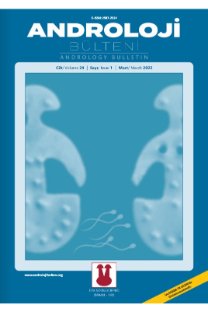Can asymptomatic inflammatory prostatitis be predicted based on C-reactive protein and sterile pyuria?
Asemptomatik inflamatuvar prostatit C-reaktif protein ve steril piyüri temelinde tahmin edilebilir mi?
___
- Polascik TJ, Oesterling JE, Partin AW. Prostate specific antigen: a decade of discovery –What we have learned and where we are going. J Urol 1999;162:293–306. [CrossRef]
- Constantinou J, Feneley MR. PSA testing: an evolving relationship with prostate cancer screening. Prostate Cancer Prostatic Dis 2006;9:6–13. [CrossRef]
- Kawakami J, Siemens DR, Nickel JC. Prostatitis and prostate cancer: implications for prostate cancer screening. Urology 2004;64:1075–80. [CrossRef]
- Brawn PN, Speights VO, Kuhl D, Riggs M, Spiekerman AM, McCord RG, et al. Prostate-specific antigen levels from completely sectioned, clinically benign, whole prostates. Cancer 1991;68:1592–9. [CrossRef]
- Irani J, Levillain P, Goujon JM, Bon D, Doré B, Aubert J. Inflammation in benign prostatic hyperplasia: correlation with prostate specific antigen value. J Urol 1997;157:1301–3. [CrossRef]
- Schatteman PH, Hoekx L, Wyndaele JJ, Jeuris W, Van Marck E. Inflammation in prostate biopsies of men without prostatic malignancy or clinical prostatitis: correlation with total serum PSA and PSA density. Eur Urol 2000;37:404–12. [CrossRef]
- Yaman O, Göğüş C, Tulunay O, Tokatli Z, Ozden E. Increased prostate-specific antigen in subclinical prostatitis: the role of the aggressiveness and extension of inflammation. Urol Int 2003;71:160–4. [CrossRef]
- Simardi LH, Tobias-MacHado M, Kappaz GT, Taschner Goldenstein P, Potts JM, Wroclawski ER. Influence of asymptomatic histologic prostatitis on serum prostate-specific antigen: a prospective study. Urology 2004;64:1098–101. [CrossRef]
- Kwak C, Ku JH, Kim T, Park DW, Choi KY, Lee E, et al. Effect of subclinical prostatic inflammation on serum PSA levels in men with clinically undetectable prostate cancer. Urology 2003;62:854– 9. [CrossRef]
- Nickel JC. Prostatitis. Can Urol Assoc J 2011;5:306–15. [CrossRef]
- Dalton DL. Elevated serum prostate-specific antigen due to acute bacterial prostatitis. Urology 1989;33:465. [CrossRef]
- Neal DE, Moon TD, Clejan S, Sarma D. Prostate specific antigen and prostatitis I. Effect of prostatitis on serum PSA in the human and nonhuman primate. Prostate 1992;20:105–11. [CrossRef]
- Yli-Hemminki TH, Laurila M, Auvinen A, Määttänen L, Huhtala H, Tammela TL, Kujala PM. Histological inflammation and risk of subsequent prostate cancer among men with initially elevated serum prostate-specific antigen (PSA) concentration in the Finnish prostate cancer screening trial. BJU Int 2013;112:735–41. [CrossRef]
- Buddingh KT, Maatje MGF, Putter H, Kropman RF, Pelger RCM. Do antibiotics decrease prostate-specific antigen levels and reduce the need for prostate biopsy in type IV prostatitis? A systematic literature review. Can Urol Assoc J 2018;12:E25–30. [CrossRef]
- Kato T, Suzuki H, Komiya A, Imamoto T, Naya Y, Tobe T, Ichikawa T. Clinical significance of urinary white blood cell count and serum C-reactive protein level for detection of non-palpable prostate cancer. Int J Urol 2006;13:915–9. [CrossRef]
- Krieger JN, Nyberg L Jr, Nickel JC. NIH consensus definition and classification of prostatitis. JAMA 1999;282:236–7. [CrossRef]
- Oliyide AE, Tijani KH, Jeje EA, Anunnobi CC, Adeyomoye AA, Ojewola RW, et al. The role of transrectal ultrasound-guided fineneedle aspiration biopsy in the diagnosis of prostate cancer: Sextant versus extended protocol. Niger Postgrad Med J 2017;24:236–9. [CrossRef]
- Hammerer PG, McNeal JE, Stamey TA. Correlation between serum prostate specific antigen levels and the volüme of the individual glandular zones of the human prostate. J Urol 1995;153:111–4. [CrossRef]
- Fleshner NE, O’Sullivan M, Fair WR. Prevalence and predictors of a positive repeat transrectal ultrasound guided biopsy of the prostate. J Urol 1997;158:505–8. [CrossRef]
- Park SJ, Miyake H, Hara I, Eto H. Predictors of prostate cancer on repeat transrectal ultrasound-guided systematic prostate biopsy. Int J Urol 2003;10:68–71. [CrossRef]
- Tobias-Machado M, Corrêa TD, De Barros EL, Wroclawski ER. Antibiotic prophylaxis in prostate biopsy: a comparative randomized clinical assay between ciprofloxacin, norfloxacin and chloramphenicol. Int Braz J Urol 2003;29:313–9. [CrossRef]
- Blumenfeld W, Tucci S, Narayan P. Incidental lymphocytic prostatitis. Selective involvement with nonmalignant glands. Am J Surg Pathol 1992;16:975–81. [CrossRef]
- Kandirali E, Boran C, Serin E, Semercioz A, Metin A. Association of extent and aggressiveness of inflammation with serum PSA levels and PSA density in asymptomatic patients. Urology 2007;70:743– 7. [CrossRef]
- Gui-Zhong L, Libo M, Guanglin H, Jianwei W. The correlation of extent and grade of inflammation with serum PSA levels in patients with IV prostatitis. Int Urol Nephrol 2011;43:295–301. [CrossRef]
- Arthur R, Williams R, Garmo H, Holmberg L, Stattin P, Malmström H, et al. Serum inflammatory markers in relation to prostate cancer severity and death in the Swedish AMORIS study. Int J Cancer 2018;142:2254–62. [CrossRef]
- Toriola AT, Laukkanen JA, Kurl S, Nyyssönen K, Ronkainen K, Kauhanen J. Prediagnostic circulating markers of inflammation and risk of prostate cancer. Int J Cancer 2013;133:2961–7. [CrossRef]
- Platz EA, De Marzo AM. Epidemiology of inflammation and prostate cancer. J Urol 2004;171:S36–40. [CrossRef]
- Thurner E, Krenn-Pilko S, Langsenlehner U, Stojakovic T, Pichler M, Gerger A, et al. The elevated C-reactive protein level is associated with poor prognosis in prostate cancer patients treated with radiotherapy. Eur J Cancer 2015;51:610–9. [CrossRef]
- Xu Q, Chen YJ, Liu ZQ, Chu L, Fang JM, Zhang X, Zhao HX. Prognostic role of C-reactive protein in prostate cancer: a systematic review and meta-analysis. Asian J Androl 2014;16:467– 71. [CrossRef]
- Aldemir M, Ener K, Dehni D, Ağras K, Kayıgil Ö. Evaluation of the relationship between prostate cancer and serum inflammation markers. Int J Nephrol Urol 2010;2:244–50.
- ISSN: 2587-2524
- Yayın Aralığı: 4
- Başlangıç: 1999
- Yayıncı: Turgay Arık
Parmak ve el ölçüm değerleri ve sağ-sol değerler arasındaki farkın semen parametleri ile ilişkisi
Mehmet Zeynel KESKİN, Yusuf Özlem İLBEY, Tugba ZEYREK
Kadın cinsel fonksiyon bozukluklarında fitoterapi
Dilek AYGİN, AYSEL GÜL, ÖZGE YAMAN, Hande CENGİZ
Selamettin DEMİR, Abdullah GÜL
Kadın cinsel fonksiyon bozuklukları: 2018 güncelleme
HANDAN ÖZCAN, NEZİHE KIZILKAYA BEJİ
